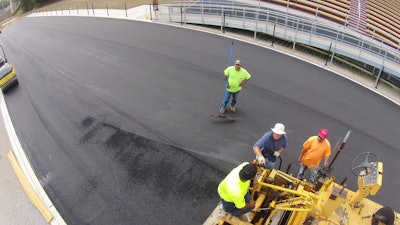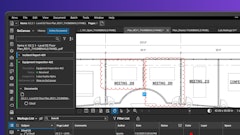
Whether paving an Olympic level running track, a High School running track or a municipal tennis court, the three critical criteria of proper smoothness, planarity and density of the asphalt pavement is of paramount importance when it comes to the performance, longevity and most importantly, safety of any athletic surface.
Quite often these fundamentals are overlooked as the buyers focus almost entirely on the glamorous or sexy portion of their purchase, the surface of the running track, tennis court or other sports facility surface. Also, there is confusion on the importance of laser-controlled grading versus laser-controlled asphalt paving and which is most crucial to the success of the final product. We will discuss that in a moment however the only way to consistently achieve the critical criteria of smoothness, planarity and density is through the proper use of laser technology, but especially laser-controlled asphalt paving.
The Difference Between Laser- Controlled Grading Versus Laser- Controlled Paving
Laser-controlled grading is the “fine tuning” of the sub-base prior to asphalt paving with equipment including bull dozers, road graders, and other fine grading equipment that is outfitted with laser- control technology. Having this technology is of the utmost importance and will allow for proper base or stone base installation and to the tolerances necessary to allow for the asphalt paving to be installed as required.
Laser-controlled paving is the process of paving with paving equipment equipped with laser- control technology which will allow a competent paving crew to achieve the tightest design tolerances possible. Without this precision, the synthetic surface cannot perform to its potential!
Keep in mind, the more often any laser technology can be utilized properly, the better. If one can use lasers effectively to build the sub-grade, install the drainage, install the stone base and install the asphalt, an owner should get the highest quality product and enjoy maximum protection of investment.
Choosing Between Laser- Controlled Grading Versus Laser Controlled Paving
If you have to choose between laser- controlled grading versus laser- controlled paving, then there is only one choice and that is laser- controlled paving. Having been in this industry and performing my own asphalt paving for approximately 45 years, I can tell you first hand that an incompetent paving crew, always has the capability to destroy any perfectly graded job.
On the flip side, a competent paving crew, utilizing laser control technology, can always save a poor grading job, unless of course it is so bad or unrecoverable in which case a competent paving crew would refuse to pave in the first place. Regardless, the important point is to require as much laser-control technology as possible, but especially laser -controlled asphalt paving.
Why Smoothness, Planarity and Density are so Critical to your Athletic Surface
Smoothness- Smoothness is measured as a deviation from perfect planarity. The typical tolerance for running tracks is plus and minus 1/8” for some manufacturers, with a maximum deviation of ¼” by others. Personally, I favor 1/8”as the goal, but we will discuss that later. The pavement surface, once installed, is measured and inspected utilizing a good quality 10 foot aluminum straight edge “or equal” type tool, in any ten foot direction. Deviations discovered by the straight- edge test, greater than the tolerance allowed, typically with some leeway, must be corrected before the synthetic surface is installed.
Proper smoothness is the most important criteria relating to uniformity of the new synthetic surface thickness, and the success of the performance, longevity and safety of the new synthetic surface!
You will not be able to see a problem with the uniformity of the synthetic surface once the surface is installed, so it is of the utmost importance to get the pavement correct before installation of your synthetic surface. One can easily envision, if a surfacing contractor is installing a 3/8” (10mm) synthetic surface where the receiving surface has high deviations (bumps) of 1/4” or greater, then the thickness of the surface will be only 1/8” thick or less in that area.
Again, you will not be able to see this from a surface view or above, but the minimal thickness will result in substantially reduced longevity, hard spots and potential safety issues. As eluded to earlier, I am a believer in a tolerance deviation goal of plus and minus 1/8” in 10 feet. With typical synthetic surface system thicknesses of 3/8” (approx. 10mm) to ½” (approx. 13mm), a surface system can ill afford to lose 67% (for 3/8” systems) and 50% (for 1/2”systems) of its thickness when ¼ “ deviations or greater are allowed.
The reality is, with any deviation goal, some lenience or leeway is afforded the contractor, as it is understood how incredibly difficult this type of asphalt paving, but plus and minus 1/8” deviations grow to 3/16”, and ¼” deviations become 5/16”, so setting the bar higher, is definitely in the best interest of the final product and the owner. I believe setting the deviation goals tighter - forces the industry to be more responsible and shoot for higher quality. The only way to obtain this kind of quality on a consistent basis is with the proper use of laser control technology but especially laser- controlled asphalt paving!
Planarity – Planarity relating to sports surfaces includes a combination of smoothness and the slope the pavement plane is designed for. Asphalt paving for sports surfaces and especially track and field, is the most difficult endeavor in the paving world, as typical slope requirements allowed are between 0-2% for high schools and 0-1% for colleges.
In the case of NCAA high jump complexes, the pavement plane or slope cannot exceed 4/10 of one percent or approximately ½” in ten feet. To make matters worse, the design plane or slope is always reduced (sometimes to as little .25%) to help ensure that the plane or slope does not exceed the maximum allowed. That equates to a fraction more than ¼ inches in ten feet. Anyone who understands asphalt or concrete paving would deem that ridiculous to even attempt. However a good paving crew who understands how to fully utilize laser control technology, and is adept at their craft, can attain these difficult design slopes.
The point to understand is, any company attempting to achieve proper planarity and the highest level of quality, cannot do so without proper utilization of laser control technology but especially laser controlled asphalt paving!
Multiple layers of asphalt and how they relate to Smoothness, Planarity and Longevity
I once read that each layer of asphalt that is properly installed with an asphalt paver improves the preceding layer by 86 %. Although I cannot be sure of the actual percentage of improvement, I am a firm believer that each additional layer of asphalt, properly installed, does significantly improve the preceding layer. Therefore it is my opinion, that to attain the smoothness and planarity tolerances required by the synthetic surface manufacturers, that multiple layers of asphalt must be installed.
In addition and just as important, is the concept that the asphalt pavement life cycle should at least match that of the proposed synthetic surface life cycle. If you are installing a synthetic surface that is expected to last 20-30 years, you had better construct a pavement profile that will last at least as long. For this, multiple layers of asphalt must be installed. The total thickness will depend on the geographic region, however I believe that in warmer regions, a minimum of 2 inches DOT base asphalt and 1 1/2 inches of DOT surface asphalt, or something very similar, should be installed. In northern climates, it is not uncommon to see specifications requiring two lifts totaling 6 inches asphalt depth. I am in total agreement and I believe a specification with 4 inches DOT base course and 2 inches DOT surface course, or something very similar, is an optimal design. If you want longevity, the thicker the depth of properly installed asphalt the better!
Density – Density relating to asphalt pavements is measured by how compacted or dense you can make the pavement profile. Using the illustration of a standard 12 inch high 5 gallon bucket, if one was simply to fill this bucket to the top with loose dirt, you could imagine that the material would be somewhat soft, fluffy; resulting in lots of air voids between the particles and you could easily push your hand to the bottom of the bucket.
Placed in the bucket this way, the material would be considered in its most un-dense or un-compressed state. However, if you placed the same amount of loose dirt in the bucket in four, three inch layers, and compressed each layer with a suitable compaction device, as tightly as possible, or to maximum density, you would find that it would now be impossible to push your hand to the bottom of the bucket.
In addition, the top of the dirt would now be compressed approximate 20-25%, below the top ridge of the bucket, depending on the type of dirt material. What has been achieved is maximum density with minimal air voids.
This phenomenon is exactly what one is looking for when constructing asphalt pavements for roadways, running tracks, tennis courts or any asphalt pavement structure. The more dense the stone base and asphalt, the less air voids in each component, the less water intrusion, the longer lasting the pavement will be. When you are installing a synthetic surface, where you are hoping to achieve a 20-25 year life cycle, it would only make sense to construct a pavement that will be sound and functional for a minimum of 20-25 years as well. Without optimal density, this is not possible! 3
How Density is Related To Laser-Controlled Technology
So how is all of this density talk related to laser control technology and the optimal quality of your new synthetic surface? The answer is twofold as there are two conditions relating to grading, paving and density that are mandatory for the longevity and performance of your surface.
First, the more uniform your pavement layers, the more uniform will be your compaction or density. Did you know you can actually over compact asphalt, shattering the aggregate and resulting in a degradation of density?
So if your layers are not uniform, but you make the exact same effort to compact every inch of the entire pavement surface, one will either over compact the thinner portion or under compact the thicker portion. Simply put, the more uniform the layers, the more uniform your compaction and density, the longer lasting will be your pavement.
How does one achieve the most uniform layers possible? With laser control technology but especially laser- controlled asphalt paving!
Secondly, and as discussed above, smoothness is critical to uniformity of thickness thus the performance, longevity and safety of your new surface and smoothness is also directly related to uniform compaction and density of the asphalt layers.
All materials compact at a specific percentage. In the case of asphalt, it compacts to optimal density by approximately 20%.
More specifically, if you desire a 1 inch compacted thickness, you would then install 1.25 inches of loose, un-compacted material with your asphalt paver, thus achieving a desired thickness of 1 inch. One would install approximately 2.5 inches to achieve 2 inches compacted thickness and so on.
Based upon this information, one can easily see how important it is to have uniform layers of asphalt when installing synthetic surfaces that are only 3/8”-1/2” thick. To illustrate further, suppose a paving contractor is paving over a stone base that is plus and minus one inch from the designed plane and his goal is to install 3 inches compacted thickness. This means, that some areas of his stone base will be one inch high, allowing for only 2 inches of asphalt and some areas will be one inch low, requiring 4 inches of asphalt. This amount of deviation, thus lack of uniformity for the asphalt layer, will create a huge problem relating to smoothness!
We just discussed uniformity of layers and density but let’s see how this greatly affects smoothness. Based upon our example above, a compaction rate for asphalt of approximately 20% and a loose thickness of 3.75 inches where the stone base is correct, we can expect ¾ inch compaction. However, where the stone base is high, allowing for only 2 inches of compacted asphalt material, we will only obtain compaction of approximately 7/16 inches leaving an approximately ¼ inch bump or high area of the asphalt relating to the three inch optimally graded area. In the case of the area that is one inch low and requiring 4 inches of asphalt, we will get additional compaction of approximately 7/16 inches resulting in depressions of approximately ¼ inch in relation to the optimally graded 3 inch areas.
What this means for your synthetic surface is, there is only space for approximately ¼ inch of material on the high areas, where the owner has contracted for ½ inch and where areas are now depressed or low, there will be additional thickness of approximately ¾ inches or so. The high areas will result in hard spots and decreased longevity due to their lack of thickness and the low spots will be heavy with material, softer and of a different feel then the other areas of the track. These are significant problems that must be minimized with competently operated laser controlled asphalt paving!
Safety Hazards for Your Athletes
In addition and perhaps most importantly, one could easily argue that the various feels between the hard and soft spots on a track create a significant safety hazard to the participants. Imagine an athlete, heavy in focus during a very competitive meet, hitting the take off point for a high hurdle and finding an unusual soft spot or different feel at the moment of departure. Would it not be reasonable to think that this could break his or her concentration and ability to clear the hurdle safely, or at minimum, affect their stride? How about the soft or hard spot on the far side of the hurdle, could this different feel also result in a break of stride, concentration or worse?
The important point is that the goal must be to create a surface that is as uniform as possible so that maximum performance, longevity and safety is achieved for the kids and participants who will use these facilities. The only way is to insist on the use of laser technology but especially laser- controlled asphalt paving!
In closing, the most important goals of any impassioned owner, designer or contractor should be:
- to build a running track or sports facility that performs to the highest level achievable
- to build a running track or sports facility that will last as long as possible
- to build a running track or sports facility to be as safe as possible for the kids and participants who will use that facility
When pondering this concept, I cannot help but remember an important article published a few years ago by Mary Helen Sprecher in Athletic Business Magazine, titled “A Tennis Court is not a Parking Lot and a Running Track is not a Roadway”. http://www.athleticbusiness.com/Staffing/in-search-of-a-qualified-track-and-tennis-court-builder.html In that article the point was made, how important it is for owners and designers to employ only contractors who have the requisite experience and capability to build your sports facilities to the highest standards possible.
I hope I have driven home the point that the only way this can be achieved is with maximum use of laser-control technology and especially laser- controlled asphalt paving.
Let’s protect the huge investments owners are making every day to build their “field of dreams” facilities and let’s protect the kids who will use these facilities by ensuring that specifications and bid documents are written to ensure maximum quality and safety!
William Narozanick is president of American Athletic, 2050 Route 206, Vincentown, NJ 08088, a leading certified sports builder since 1983. For more information visit www.trackandturf.com or contact him at 800-427-5705.

















